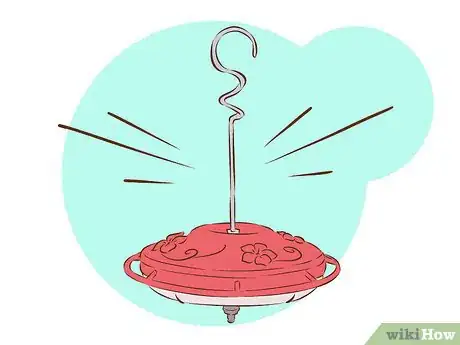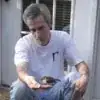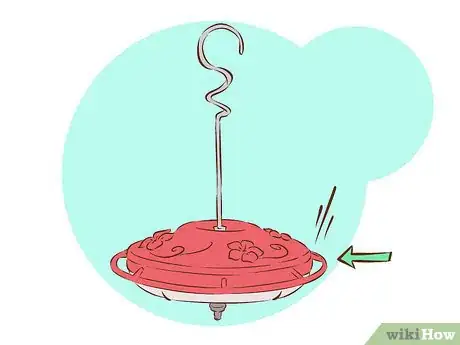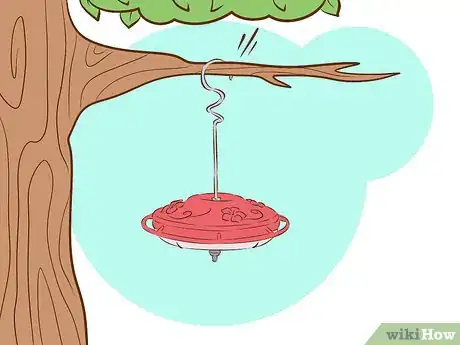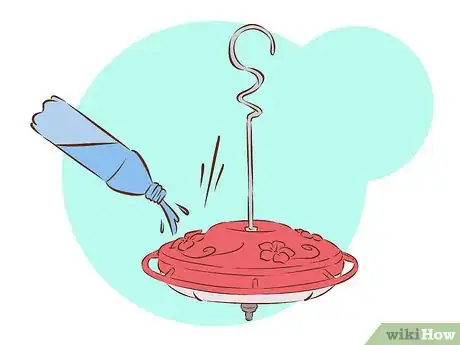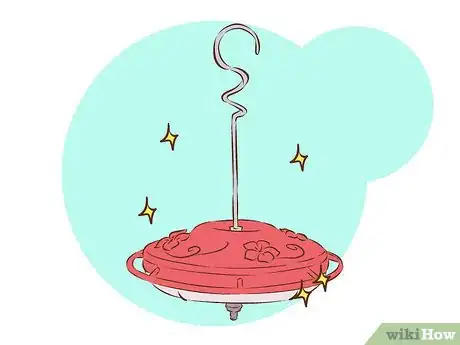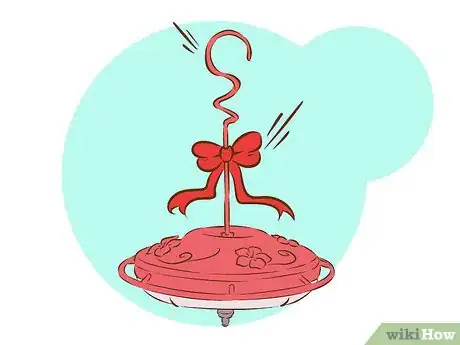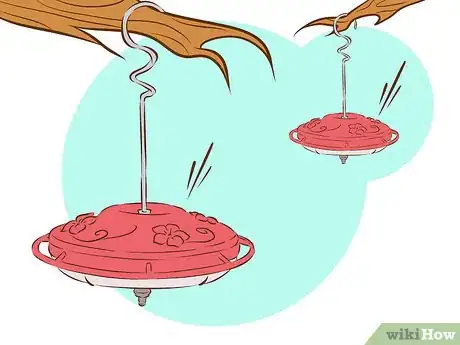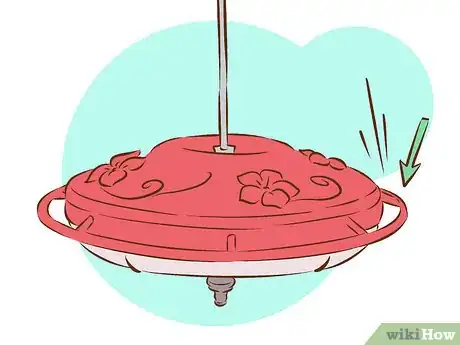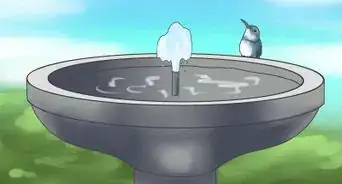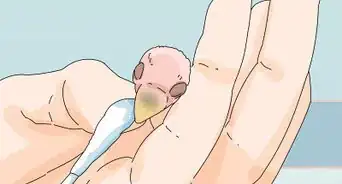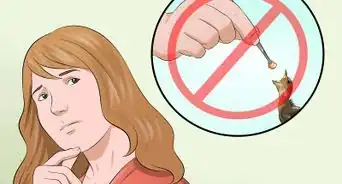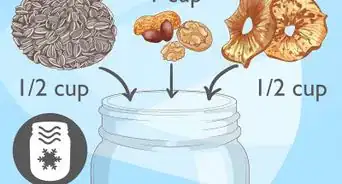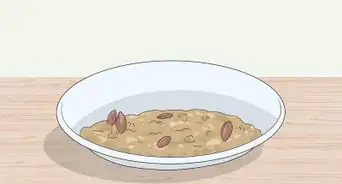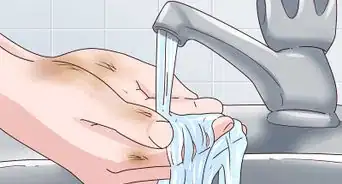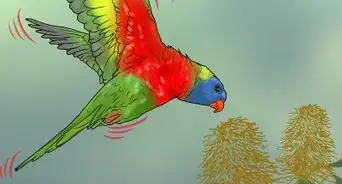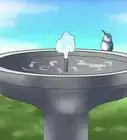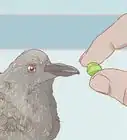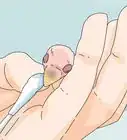This article was co-authored by Jeff Jones. Jeff Jones is a Bird Specialist based in Nashville, Tennessee. He is the writer of BirdOculars, a website dedicated to helping people become better birders. He has over 18 years of experience and specializes in feeding birds and wildlife. Jeff experiments to find ways to encourage birds he wants to study and his website help others to do the same.
wikiHow marks an article as reader-approved once it receives enough positive feedback. In this case, several readers have written to tell us that this article was helpful to them, earning it our reader-approved status.
This article has been viewed 47,233 times.
Hummingbird feeders bring these incredibly small jewel-like creatures up close where you can observe and enjoy them while providing them with a reliable source of energy. A well-designed commercial feeder plus a homemade solution of sugar and water can either complement or substitute for the sugar-rich flower nectar that fuels hummingbirds' fast-paced lifestyle.
Steps
Setting Up Your Feeder
-
1Select a bottle or saucer-style feeder. You want to choose a style that can be disassembled for easy cleaning and one that will hold two to three days' worth of nectar, or about 6 to 12 ounces. In general, the saucer-styles drip less, create less mess, and attract fewer bugs.
- Or you could make your own.
- Whichever style you choose, just make sure it's red (most are). Red naturally attracts hummingbirds.
-
2Make your own hummingbird nectar. While you could buy store-bought hummingbird nectar, it's ridiculously easy to make your own and much cheaper – it's just sugar water.[1] And you can make it in bulk if your little birdies go through quite a lot – it'll keep for around a week.
- Most experts suggest a ratio of 1 part sugar to 4 parts water. You simply bring it to a boil and let the sugar dissolve (see the linked wikiHow guide in the bolded step).[2] However, some sources do suggest adding just a bit more sugar during colder months to give the birds more energy. But not too much – too much more and it gets syrupy and spoils quickly.[3]
- Do not use anything besides plain sugar (can be toxic for the birds) and do not use red food coloring.
Advertisement -
3Fill it halfway full if this is your first feeder. If your yard is a first-time hummingbird stop, just start with filling your feeder halfway. Why? Sugar water can spoil and you'll need to change it in a few days anyway. Filling it halfway full creates waste (you could've stored it instead of throwing it down the drain, too).
- Once the birds start coming, you'll get a good idea of how much they're eating, how often you need to fill it, and how full you should fill it when you do.
-
1
- If it's always hot where you live, you may want to fill it halfway full at all times. Hot weather leads to faster spoiling rates.
-
2Hang it in a shady area near a window. Sugar water goes bad quickly in the sunlight, so hang your feeder under a tree in some shade if at all possible. What's more, this is respite for the birds – give them a cool, relaxing spot to take a drink and they'll surely come back.
- Late spring is the general time hummingbirds start migrating and you'll see them through your area. That being said, some experts suggest setting out your feeder a couple of weeks early for the first-arrivers. Aim to set your feeder out sometime around late March.[5]
Keeping Your Birds Fed
-
1Change your nectar every couple of days, depending on the weather. Once you fill your feeder, keep an eye on it. You'll obviously need to refill it if it's empty, but you'll also need to change out the nectar if it gets cloudy, has black spots, or white strings. These three are all signs that it's gone bad, and your birds will not come back to a feeder that isn't safe or tasty. When will it go bad? That depends on the weather:
- Temperature: 71-75 (21.5-24°C); change every 6 days
- Temperature: 76-80 (24-26.5°C); change every 5 days
- Temperature: 81-84 (26.5-29°C); change every 4 days
- Temperature: 85-88 (29-31°C); change every 3 days
- Temperature: 89-92 (31-33°C); change every 2 days
- Temperature: 93+ (33°C+); change daily
-
2Use an ant guard. Hummingbirds will not come to a feeder that is covered in ants or that has dead ants swimming in the saucer. To prevent ants from spoiling all your efforts, use an ant guard – it's a little tray that's full of water (a moat, really) that you attract the the cord on top of your feeder. The ants can't pass the water without drowning.
- Some feeders come with this while others do not. In certain home and gardening stores (or online) you can purchase an ant guard individually.
- Some people suggest putting putting petroleum jelly on top of the feeder to create a sticky goo the ants get through. This may work, but in hot weather, you run the risk of the jelly melting and getting into the birds' food.
-
3Keep away the bees. Bees are another unwanted animal that you'll have to keep away from your feeder – they'll even be territorial with the birds. They're harder to get away than ants. In general, there are three things you can do:
- Keep the feeder clean at all times. Residue from splashing and dripping will attract the bees.
- Place a saucer of sugar water (a 1:1 ratio, much stronger) elsewhere in your yard.
- Buy a feeder that has tubes. Only the hummingbirds will be able to get into the tubes to the sugar water and the bees won't sense the delicacy.
-
4Clean out the feeder regularly. In general, you want to clean out your feeder every time you go to refill it (hence why an easy-to-clean feeder is important). Use a scrub brush and mild soap and water and just take a minute to get it fresh. And get the soap off too – you don't want soap ruining the birds' dinner.
- This is especially important if the sugar water has gone bad – again, if there are white strings, black spots, or if it's cloudy. If you don't clean it well, your next batch will spoil faster.
Attracting More Hummingbirds
-
1Put more red around your feeder. Hummingbirds love, love, love the color red. You might say it even hypnotizes them a bit. If you're not getting any birds in your area, put more red up in your garden. Tie a ribbon around your feeder to attract them or even put red tape near the area. It doesn't have to be perfect, it just has to be red.
- Red paint and even red nail polish to touch up certain pieces in your garden can go a long ways, too.
-
2Plant red, orange, and yellow flowers in your garden. Another way to get hummingbirds to your garden is to plant a garden full of brightly-colored flowers. The more eye-catching your garden, the better. Here are some flowers you can plant:[6]
- Geraniums
- Fuchsia
- Trumpet vines
- Columbine
- Petunias
-
3Place several different feeders in different areas. Hummingbirds tend to be very territorial. If you only have one feeder, you may find that one alpha hummingbird drives away the smaller birds from the nectar. To get around this, invest in a few different feeders and put them in different areas of your yard.
- If they're out of sight, that's even better. Have one in your front and back yards if possible, or at least in faraway trees.
-
4Place a perch on your feeder. If you're looking for a rare sight, buy a perch for your feeder or construct one. You'll see your speedy little birds actually stop for a rest – a gem of a sight.
- If you can't find a feeder with a perch, try making your own. Get your camera ready!
Expert Q&A
-
QuestionHow do you make sugar water for hummingbirds?
 Jeff JonesJeff Jones is a Bird Specialist based in Nashville, Tennessee. He is the writer of BirdOculars, a website dedicated to helping people become better birders. He has over 18 years of experience and specializes in feeding birds and wildlife. Jeff experiments to find ways to encourage birds he wants to study and his website help others to do the same.
Jeff JonesJeff Jones is a Bird Specialist based in Nashville, Tennessee. He is the writer of BirdOculars, a website dedicated to helping people become better birders. He has over 18 years of experience and specializes in feeding birds and wildlife. Jeff experiments to find ways to encourage birds he wants to study and his website help others to do the same.
Bird Specialist Add four cups of sugar, to one cup of water. Boil the water, stir and return to a boil. Let the sugar solution cool down before storing it in a container.
Add four cups of sugar, to one cup of water. Boil the water, stir and return to a boil. Let the sugar solution cool down before storing it in a container. -
QuestionDo you have to boil sugar water for hummingbirds?
 Jeff JonesJeff Jones is a Bird Specialist based in Nashville, Tennessee. He is the writer of BirdOculars, a website dedicated to helping people become better birders. He has over 18 years of experience and specializes in feeding birds and wildlife. Jeff experiments to find ways to encourage birds he wants to study and his website help others to do the same.
Jeff JonesJeff Jones is a Bird Specialist based in Nashville, Tennessee. He is the writer of BirdOculars, a website dedicated to helping people become better birders. He has over 18 years of experience and specializes in feeding birds and wildlife. Jeff experiments to find ways to encourage birds he wants to study and his website help others to do the same.
Bird Specialist Hot water will usually dissolve the sugar. After boiling let the sugar solution cool down. If you plan on making extra hummingbird sugar water store it in the refrigerator.
Hot water will usually dissolve the sugar. After boiling let the sugar solution cool down. If you plan on making extra hummingbird sugar water store it in the refrigerator. -
QuestionCan I put a feeder out now in Georgia?
 Amy HarrisonTop AnswererYou can keep them out year-round. Most say keep to them out during fall and winter especially to help struggling hummingbirds.
Amy HarrisonTop AnswererYou can keep them out year-round. Most say keep to them out during fall and winter especially to help struggling hummingbirds.
Warnings
- Do not substitute powdered sugar, brown sugar, "raw" sugar, honey, or artificial sweeteners for white sugar.⧼thumbs_response⧽
- Feeders that cannot be completely disassembled for cleaning require much more thorough cleaning and rinsing than better designed models. especially if dishwashing detergent is used to clean them.⧼thumbs_response⧽
- Do not make the sugar water with either mineral-free water purified by distilling or reverse-osmosis or tap water that produces iron stains in sinks and toilets.⧼thumbs_response⧽
- Hot tap water can contain dangerous amounts of lead, so use only cold water or water heated on the stove or in the microwave to make the feeder solution.⧼thumbs_response⧽
Things You'll Need
- Hummingbird feeder
- Measuring cups
- Nectar (make your own)
- Plastic or metal spoon
- Scrubber
- Glass or plastic container for refrigerating leftovers
References
- ↑ Jeff Jones. Bird Specialist. Expert Interview. 13 May 2021.
- ↑ Jeff Jones. Bird Specialist. Expert Interview. 13 May 2021.
- ↑ http://www.allaboutbirds.org/page.aspx?pid=1181
- ↑ Jeff Jones. Bird Specialist. Expert Interview. 13 May 2021.
- ↑ http://www.rubythroat.org/feedinghintsmain.html
- ↑ http://www.allaboutbirds.org/page.aspx?pid=1181
- Williamson, S. 2000. Attracting and Feeding Hummingbirds. (Wild Birds Series) T.F.H. Publications, Neptune City, New Jersey. ISBN 0-7938-3580-1
About This Article
To feed hummingbirds, first make your own hummingbird nectar by boiling 1 part sugar and 4 parts water until the sugar dissolves. Don't add anything besides plain sugar, like food coloring, since other ingredients can be toxic to birds. Once you've made the nectar, put it in a bottle or saucer-style feeder that's red since the color red attracts hummingbirds. Finally, hang the feeder up in a shady area near a window. To learn how often you should replace the hummingbird nectar, keep reading!
